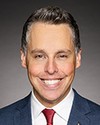I think it would really benefit this study to understand that in greater detail. I understand from Mr. Bijimine, who was with us earlier at this meeting, that Transport Canada is looking at the U.S. example, but it would really help us with our recommendations if we understood in greater detail how that program works.
Therefore, if it's in order as an emerging motion, Mr. Chair, I will move that the committee invite a representative from the U.S. Department of Transportation to appear as a witness as part of this current study.


